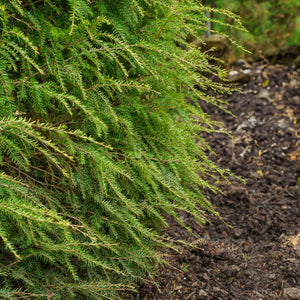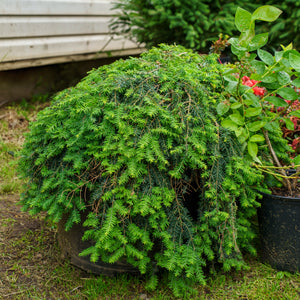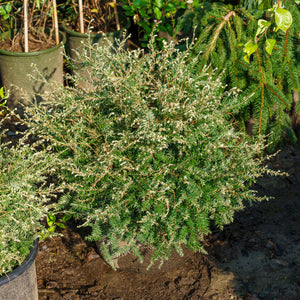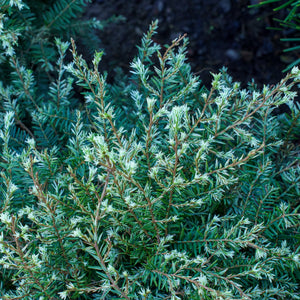The Hemlock Guide
Hemlocks are graceful evergreen conifers known for their fine-textured foliage, nodding branch tips, and layered, architectural structure. Most commonly represented in landscapes by Tsuga canadensis, or Eastern hemlock, these trees are valued for their soft needles, shade tolerance, and naturalistic beauty. Hemlocks bring four-season interest with their deep green foliage and weeping forms, and they are particularly well-suited to woodland gardens, shady borders, and naturalized plantings.
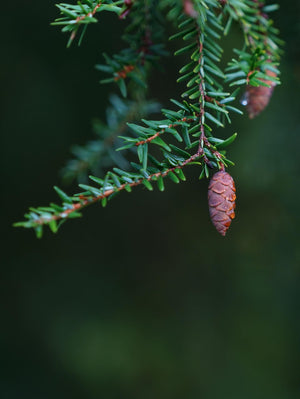
About
The genus Tsuga includes several species native to North America and Asia, with Tsuga canadensis (Eastern hemlock) being the most widely cultivated in the U.S. This species is native to eastern North America and thrives in cool, moist, shaded environments, where it forms majestic groves in forested areas. It is a long-lived species, with individual trees capable of living for several hundred years.
A wide range of cultivars has expanded hemlock’s use in ornamental settings. Upright varieties such as Tsuga canadensis ‘Don Smith’ offer manageable size and refined branching, while spreading selections like ‘Cole’s Prostrate’ and ‘Lustgarten Creeping’ are ideal for groundcover or slope applications. Cascading forms like Tsuga canadensis pendula and Tsuga canadensis ‘Sargentii’ bring a weeping elegance to focal points or elevated planting sites. Variegated options such as ‘Gentsch White’ provide unique seasonal color as new growth emerges with a silvery-white cast.
Tsuga diversifolia, the Japanese hemlock, offers a denser and darker green habit with slightly stiffer needles. Cultivars like ‘Loowit’ bring dwarf or compact traits, making them excellent for foundation plantings and rock gardens.
Despite their common name, hemlock trees are not related to the poisonous herb of the same name (Conium maculatum). Hemlock trees are not toxic to humans or pets and are perfectly safe for landscape use.
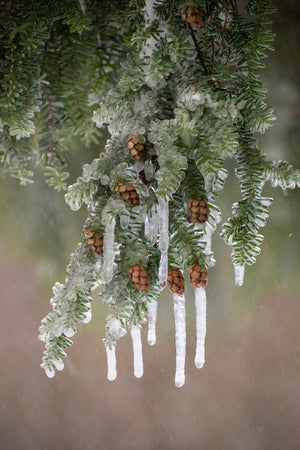
PLANTING
Hemlocks perform best when planted in the right conditions, with attention to soil, moisture, and protection from extreme heat.
USDA Hardiness Zones: Most hemlocks thrive in Zones 3–7. Tsuga canadensis may struggle in hot or dry climates, while Tsuga diversifolia performs well in more temperate zones.
Soil: Prefers moist, acidic, well-drained soils high in organic matter. Avoid heavy clay or alkaline conditions. Mulching helps maintain ideal soil structure and pH.
Sunlight: Hemlock is one of the few conifers that tolerates partial to full shade. It grows best in dappled sunlight or morning sun with afternoon shade. In cooler climates, full sun is acceptable if soil moisture is maintained.
Watering: Regular watering is essential, especially during the first two years. Hemlocks dislike drought and perform best in evenly moist conditions.
Spacing: Full-sized hemlocks should be spaced 20–30 feet apart. Dwarf and prostrate cultivars like ‘Loowit’ and ‘Cole’s Prostrate’ can be spaced 3–6 feet apart depending on desired spread.
Planting Time: Spring or fall is best for planting. Avoid midsummer planting unless supplemental irrigation can be provided during dry periods.
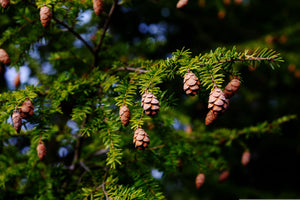
CARE
Hemlocks are low-maintenance once established, but proper early care and environmental awareness can ensure long-term health and vigor.
Watering: Deep, consistent watering is critical during establishment. Mature hemlocks still benefit from supplemental watering during dry spells, particularly in hot climates.
Fertilizing: Apply a slow-release, acid-forming fertilizer in spring if foliage is pale or growth is weak. Avoid over-fertilizing, which can cause excessive, weak growth.
Pruning: Prune lightly in early spring to maintain shape or remove damaged or crossing branches. Weeping and dwarf forms may benefit from occasional corrective pruning to preserve their form.
Pests & Diseases: The hemlock woolly adelgid (HWA) is a serious pest in many regions. Monitor for signs of infestation—white, cottony masses on needle bases—and treat promptly with horticultural oil or systemic insecticides. Healthy, well-watered trees are more resistant to damage.
Mulching: Apply 2–3 inches of mulch to regulate soil temperature, retain moisture, and suppress weeds. Keep mulch several inches from the trunk to prevent rot.
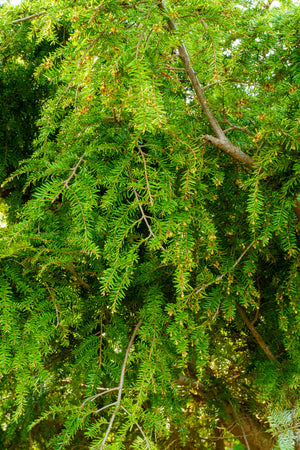
HOW TO USE
Hemlocks offer unmatched versatility and beauty in the landscape. Their soft texture, layered form, and year-round greenery make them ideal for a variety of design applications, from grand specimen trees to low-growing groundcovers.
Focal Point: Cascading selections like Tsuga canadensis pendula and ‘Sargentii’ are outstanding focal points in foundation beds, near water features, or when placed on berms and slopes where their arching branches can be fully appreciated. These cultivars bring a quiet elegance and timeless formality to the landscape.
Woodland and Shade Gardens: Hemlocks thrive in the shaded understory of woodland gardens, where their soft needles and fine branching contrast beautifully with broadleaf companions. Pair with rhododendrons, mountain laurels, ferns, and woodland phlox for a layered, woodland-inspired palette. Underplant with native groundcovers like foamflower or wild ginger to enhance the natural feel.
Hedges and Screening: Although slower growing than some evergreens, upright hemlock cultivars make excellent privacy screens and windbreaks. Their dense foliage responds well to shearing or can be left natural for a softer look. Use in place of arborvitae or Leyland cypress in shaded areas where those species would struggle.
Rock Gardens and Slopes: Low-growing cultivars like ‘Lustgarten Creeping’ and ‘Cole’s Prostrate’ are ideal for rock gardens or stabilizing slopes. Their spreading habit helps prevent erosion while maintaining year-round texture and color.
Foundation and Courtyard Plantings: Compact and dwarf types such as ‘Don Smith’ and Tsuga diversifolia ‘Loowit’ are well-suited for tight spaces around buildings, patios, or entryways. Their fine foliage and manageable size allow them to soften architecture without overpowering it.
Japanese and Zen Gardens: Hemlock’s naturally layered growth and delicate texture make it a perfect candidate for Japanese-inspired gardens. Use in combination with boulders, gravel, and slow-growing conifers like Hinoki cypress for a calming, structured effect.
Wildlife Habitat: Hemlocks provide shelter and nesting opportunities for birds and small mammals. In native woodland settings, they contribute to forest biodiversity and serve as host plants for certain moth and butterfly species.
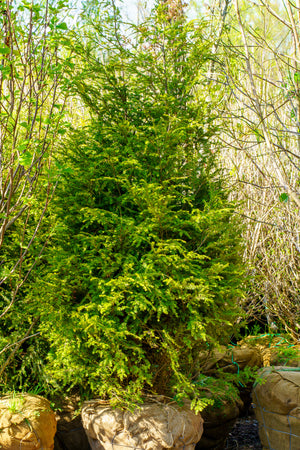
Common Questions
Is hemlock deer resistant? Hemlock is not considered deer resistant. In areas with heavy deer populations, young foliage may be browsed, particularly in winter. Fencing or repellents may be necessary for protection.
Where does hemlock grow? Hemlock grows naturally in the northeastern United States and parts of the Appalachian Mountains. It prefers cool, moist forest settings and shaded hillsides but adapts well to garden settings with similar conditions.
How tall does hemlock grow? Eastern hemlock can grow 40 to 70 feet tall in cultivated landscapes, and even taller in the wild. Dwarf and prostrate forms range from under 1 foot tall to 10–15 feet depending on cultivar and pruning.
How fast does hemlock grow? Hemlocks grow at a moderate pace—typically 12 to 24 inches per year under ideal conditions. Dwarf and weeping cultivars grow more slowly and are best for gardeners seeking long-term structure rather than rapid coverage.
Does hemlock need full sun? Hemlocks prefer partial shade to full shade, especially in warmer climates. In cool northern regions, they can tolerate full sun if soil moisture is consistent.
Is hemlock poisonous? Hemlock trees (Tsuga species) are not poisonous and are unrelated to the herbaceous poison hemlock (Conium maculatum). They are safe for pets and humans.
What does hemlock look like? Hemlock trees have short, flat needles with a soft texture and two pale stripes on the underside. Their branches are layered and slightly drooping at the tips, creating a graceful, lacy appearance. Bark is gray-brown and becomes ridged and furrowed with age.
Conclusion
Hemlocks are among the most elegant and adaptable conifers in the landscape. Their layered structure, fine foliage, and shade tolerance make them uniquely suited to woodland and naturalistic gardens, while an ever-growing selection of cultivars offers choices for everything from focal points to groundcovers. With thoughtful siting, proper moisture, and regular monitoring for pests, hemlock trees provide lasting beauty and structure for decades to come.
The Hemlock Collection
Sold Out
Sold Out
Sold Out

